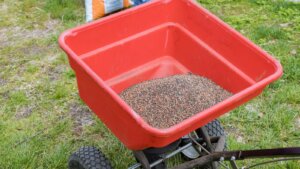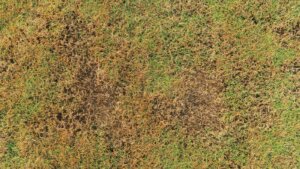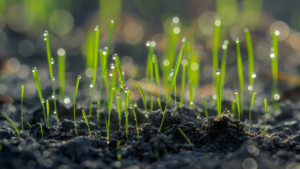If your lawn shows symptoms of yellowing leaves, stunted growth, and increased susceptibility to environmental stresses, it may have a potassium deficiency.
Potassium (K) can significantly strengthen your lawn’s defenses against harsh conditions like drought, extreme temperatures, and disease infestations.
This article will delve deeper into the benefits of potassium and how to achieve optimal potassium levels for a healthy and resilient lawn.
How Does Potassium Strengthen Your Lawn?
Adding potassium or a potassium fertilizer to your lawn care regime is essential for maintaining a beautiful, lush lawn. As one of the three essential macronutrients every plant requires to survive and thrive, along with nitrogen and phosphorus, potassium plays a vital role in a plant’s overall health.
Benefits of Potassium for Your Lawn
Potassium offers many protective functions for plants, including the following.
- Potassium enhances your lawn’s overall vitality. It fortifies the plant’s cell walls and helps your grass develop a deep and extensive root system for accessing soil nutrients, water, and oxygen. This healthy root system strengthens your lawn against harm from drought, pests, and diseases.
- Proper potassium levels also help regulate water movement in plant cells for adequate water balance. When your lawn can maintain hydration longer, it minimizes the risk of wilting and damage to the plant’s foliage in cold temperatures, drought, and heat waves.
- Finally, potassium plays a critical role in photosynthesis, the process by which plants convert sunlight into energy. Adequate potassium levels help the grass absorb and utilize light energy efficiently, which promotes faster growth and ensures that the plant remains healthy.
How to Manage Potassium Levels for a Resilient, Thriving Lawn
Too much or too little potassium can adversely affect your lawn, causing yellowing or browning of leaves, reduced growth, and increased susceptibility to pests and diseases. Here’s how to achieve optimal potassium levels for a healthy lawn.
Conduct a Soil Test
Evaluating the pH level, organic matter content, and available nutrients in your soil allows you to make informed decisions about what amendments and fertilizers to use. You can purchase a soil testing kit at most garden centers or contact a professional for analysis.
Choose a Potassium Fertilizer
Select a fertilizer with a balanced ratio of nitrogen, phosphorus, and potassium, often labeled N-P-K. For potassium-deficient lawns, choose a fertilizer with a higher proportion of potassium. Generally, fertilize lawns in the spring and fall when the grass is actively growing but not under stress from heat or cold.
Topdress with Compost
Compost is rich in nutrients and organic matter and is a great way to improve soil structure and add potassium. Topdressing a lawn involves applying a layer of compost over the grass and raking it into the soil.
A Professional Can Help Balance Your Lawn’s Potassium Levels
Promote healthy, vibrant growth for your grass. Terra Lawn Care Specialists have the expertise to analyze your soil and properly apply high-quality fertilizers and treatments to balance your lawn’s potassium levels. Contact Terra Lawn Care Specialists for a free estimate for lawn care in Montgomery County, PA.



